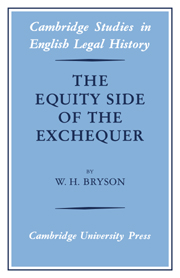Book contents
- Frontmatter
- Contents
- Preface
- Principal abbreviations
- Table of statutes cited
- 1 Introduction
- 2 The equity jurisdiction of the exchequer
- 3 The administration of the court
- 4 Procedures and records
- 5 The suppression of the jurisdiction
- Appendix 1 Chart showing the quantity of bills filed
- Appendix 2 Lists of officers
- Bibliography
- Index
3 - The administration of the court
Published online by Cambridge University Press: 07 October 2011
- Frontmatter
- Contents
- Preface
- Principal abbreviations
- Table of statutes cited
- 1 Introduction
- 2 The equity jurisdiction of the exchequer
- 3 The administration of the court
- 4 Procedures and records
- 5 The suppression of the jurisdiction
- Appendix 1 Chart showing the quantity of bills filed
- Appendix 2 Lists of officers
- Bibliography
- Index
Summary
THE OFFICERS
The personnel of the equity side of the court can be divided into judicial officers and clerical officers. The judges of the court were the treasurer, the chancellor of the exchequer, the chief baron, and the three puisne barons. At the head of the clerical staff of the court was the king's remembrancer, who was the master of the office. Under him were eight sworn clerks. Under each baron was an examiner and a clerk. In addition towards the end of the court's history, several other clerical offices were created by acts of Parliament.
This part deals primarily with the years 1550 through 1714 because this was the formative period in the establishment of the equity jurisdiction of the court. From 1714 to 1841 the developments of the various offices were not great, and therefore a summary of them will be adequate.
The treasurer
The chief judicial officer of the equity side of the court of exchequer was the lord high treasurer of England or the treasurer of the exchequer. The respective functions of these two offices has always been a matter of doubt. However, their separate existences were recognized, in the seventeenth century at least, by the two distinct titles and by the different methods of installation. The lord treasurer of England was instituted by the delivery from the king of the white staff, his symbol of office. The treasurer of the exchequer received his office by a grant by royal letters patent under the great seal and was sworn into office before the lord high chancellor.
- Type
- Chapter
- Information
- The Equity Side of the Exchequer , pp. 34 - 92Publisher: Cambridge University PressPrint publication year: 1975



